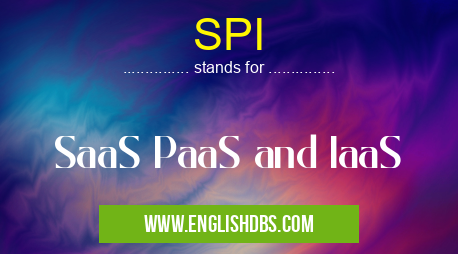What does SPI mean in TECHNOLOGY
SPI stands for SaaS, PaaS, and IaaS, which are cloud computing service models that offer varying levels of control, scalability, and management responsibility. These models provide businesses with flexible and cost-effective options for hosting their applications and data.

SPI meaning in Technology in Computing
SPI mostly used in an acronym Technology in Category Computing that means SaaS PaaS and IaaS
Shorthand: SPI,
Full Form: SaaS PaaS and IaaS
For more information of "SaaS PaaS and IaaS", see the section below.
» Computing » Technology
SaaS (Software as a Service)
- Definition: SaaS is a cloud-based software delivery model where the end-user accesses the software over the internet.
- Characteristics:
- Vendor-Managed: The vendor handles all infrastructure, updates, and maintenance.
- Subscription-Based: Users pay a monthly or annual fee for access to the software.
- Multi-Tenant: Multiple customers share the same software infrastructure, reducing costs.
PaaS (Platform as a Service)
- Definition: PaaS provides a platform for developers to build, deploy, and manage their applications.
- Characteristics:
- Infrastructure-Managed: The vendor provides the underlying hardware and software infrastructure.
- Developer-Focused: PaaS offers tools and services tailored to software development.
- Abstraction: Developers can focus on application logic without worrying about underlying infrastructure.
IaaS (Infrastructure as a Service)
- Definition: IaaS provides virtualized hardware resources, such as servers, storage, and network.
- Characteristics:
- Self-Managed: The user has full control over the virtual resources and is responsible for management.
- Pay-as-you-go: Customers pay for the resources they consume.
- Flexibility: IaaS provides a high degree of customization and scalability.
Essential Questions and Answers on SaaS PaaS and IaaS in "COMPUTING»TECHNOLOGY"
What is SaaS?
SaaS (Software as a Service) is a cloud-based software delivery model where users access applications over the internet on a subscription basis. SaaS providers host, maintain, and update the software, eliminating the need for customers to install and manage it on their own infrastructure.
What are the benefits of SaaS?
SaaS offers several benefits, including:
- Reduced IT costs: No need for upfront hardware and software purchases or ongoing maintenance expenses.
- Scalability: Easily scale up or down as business needs change.
- Accessibility: Access applications from any device with an internet connection.
- Automatic updates: Providers handle software updates and security patches, ensuring the latest version is always available.
What is PaaS?
PaaS (Platform as a Service) provides a cloud-based platform for developers to build, deploy, and manage applications without worrying about the underlying infrastructure. PaaS includes development tools, runtime environments, databases, and other services.
What are the benefits of PaaS?
PaaS offers benefits such as:
- Reduced development time: Developers can focus on application logic instead of infrastructure management.
- Increased agility: Rapid application development and deployment cycles.
- Scalability: Automatic scaling of applications based on demand.
- Cost savings: No need for hardware, software, or IT staff to manage the infrastructure.
What is IaaS?
IaaS (Infrastructure as a Service) provides virtualized computing resources, such as servers, storage, and networking, over the internet. Customers can rent these resources on a pay-as-you-go basis, allowing them to scale their infrastructure as needed.
What are the benefits of IaaS?
IaaS offers benefits such as:
- Flexibility: Customize and scale infrastructure resources to meet specific needs.
- Cost efficiency: Pay only for the resources used, reducing IT expenses.
- Control: Greater control over infrastructure management compared to other cloud models.
- Disaster recovery: Easily create backups and restore infrastructure in case of an outage.
Final Words: SPI represents the three main cloud computing service models that offer businesses a range of options for hosting their applications and data. SaaS provides fully managed software, PaaS offers a platform for development, while IaaS provides virtualized infrastructure. Understanding these models allows businesses to choose the most suitable solution based on their specific needs and requirements.
SPI also stands for: |
|
| All stands for SPI |
